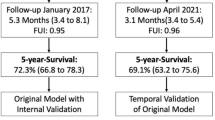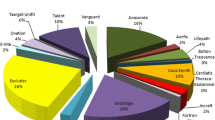Abstract
Background
This study aimed to compare the long-term survival after open (OS) or endovascular (EVAR) repair of abdominal aortic aneurysms (AAAs), exploring baseline factors that could affect long-term outcome.
Methods
We identified 774 patients (501 EVAR, 273 OS, during 1996–2004) with data on perioperative risk factors including 37 variables assessed with a standardized patient response instrument. Propensity score was used to adjust for baseline differences between the two cohorts. Matched cohorts survival analysis and Cox multivariate regression were performed.
Results
Median follow-up was 6.95 (interquartile range 4.46–9.27) years. EVAR patients were older [75.0 ± 7.7 (SD) vs. 71.3 ± 8.5 years, p < 0.001] and had a higher rate of previous myocardial infarction (39.3 vs. 25.3 %, p < 0.001), pulmonary disease (25.9 vs. 18.3 %, p = 0.020), and history of malignancy (5.0 vs. 1.8 %, p = 0.039). The 30-day mortality was comparable (1.4 % EVAR, 1.5 % OS). Although the unadjusted survival rate was lower (median survival: 7.4 years EVAR, 8.8 OS, p = 0.011) and early (within 4 years) hazard was higher after EVAR (p = 0.003), no difference in survival was observed after propensity score-matching (p = 0.688) or propensity score-adjusted Cox regression (hazard ratio 1.01, 95 % confidence interval 0.82–1.25, p = 0.911, EVAR vs. OS). There was a trend toward higher hazard later in both groups. A multivariate Cox regression identified age, pulmonary disease, stroke, dialysis, oral anticoagulation, cardiac enlargement, and smoking history as variables associated with poor survival. Lipid-lowering medication was found to be protective.
Conclusions
Over long-term follow-up, survivals after endovascular and open repair of AAA are similar. Baseline patient characteristics are correlated with survival, but whether attention to the modifiable risk factor can alter outcome remains to be defined.




Similar content being viewed by others
References
Prinssen M, Verhoeven EL, Buth J et al (2004) A randomized trial comparing conventional and endovascular repair of abdominal aortic aneurysms. N Engl J Med 351:1607–1618
Greenhalgh RM, Brown LC, Kwong GP et al (2004) Comparison of endovascular aneurysm repair with open repair in patients with abdominal aortic aneurysm (EVAR trial 1), 30-day operative mortality results: randomised controlled trial. Lancet 364:843–848
Hua HT, Cambria RP, Chuang SK et al (2005) Early outcomes of endovascular versus open abdominal aortic aneurysm repair in the National Surgical Quality Improvement Program–Private Sector (NSQIP-PS). J Vasc Surg 41:382–389
Bush RL, Johnson ML, Collins TC et al (2006) Open versus endovascular abdominal aortic aneurysm repair in VA hospitals. J Am Coll Surg 202:577–587
Lederle FA, Freischlag JA, Kyriakides TC et al (2009) Outcomes following endovascular vs open repair of abdominal aortic aneurysm: a randomized trial. JAMA 302:1535–1542
Laheij RJ, Buth J, Harris PL et al (2000) Need for secondary interventions after endovascular repair of abdominal aortic aneurysms: intermediate-term follow-up results of a European collaborative registry (EUROSTAR). Br J Surg 87:1666–1673
Sampram ES, Karafa MT, Mascha EJ et al (2003) Nature, frequency, and predictors of secondary procedures after endovascular repair of abdominal aortic aneurysm. J Vasc Surg 37:930–937
Giles KA, Landon BE, Cotterill P et al (2011) Thirty-day mortality and late survival with reinterventions and readmissions after open and endovascular aortic aneurysm repair in Medicare beneficiaries. J Vasc Surg 53:6–12
Blankensteijn JD, de Jong SE, Prinssen M et al (2005) Dutch Randomized Endovascular Aneurysm Management (DREAM) Trial Group: two-year outcomes after conventional or endovascular repair of abdominal aortic aneurysms. N Engl J Med 352:2398–2405
EVAR trial participants (2005) Endovascular aneurysm repair versus open repair in patients with abdominal aortic aneurysm (EVAR trial 1): randomised controlled trial. Lancet 365:2179–2186
Schermerhorn ML, O’Malley AJ, Jhaveri A et al (2008) Endovascular vs. open repair of abdominal aortic aneurysms in the Medicare population. N Engl J Med 358:464–474
De Bruin JL, Baas AF, Buth J et al (2010) Long-term outcome of open or endovascular repair of abdominal aortic aneurysm. N Engl J Med 362:1881–1889
Greenhalgh RM, Brown LC, Powell JT et al (2010) Endovascular versus open repair of abdominal aortic aneurysm. N Engl J Med 362:1863–1871
Chahwan S, Comerota AJ, Pigott JP et al (2007) Elective treatment of abdominal aortic aneurysm with endovascular or open repair: the first decade. J Vasc Surg 45:258–262
Conrad MF, Crawford RS, Pedraza JD et al (2007) Long-term durability of open abdominal aortic aneurysm repair. J Vasc Surg 46:669–675
Nishime EO, Cole CR, Blackstone EH et al (2000) Heart rate recovery and treadmill exercise score as predictors of mortality in patients referred for exercise ECG. JAMA 284:1392–1398
Wojcik NC, Huebner WW, Jorgensen G (2010) Strategies for using the National Death Index and the Social Security Administration for death ascertainment in large occupational cohort mortality studies. Am J Epidemiol 172:469–477
Rosenbaum PR, Rubin DB (1983) The central role of the propensity score in observational studies for causal effects. Biometrika 70:41–55
Coca-Perraillon M (2007) Local and global optimal propensity score matching. In: Proceedings of the SAS global forum 2007 conference. Paper 185-2007, pp 1–9
Hertzer NR, Mascha EJ, Karafa MT et al (2002) Open infrarenal abdominal aortic aneurysm repair: the Cleveland Clinic experience from 1989 to 1998. J Vasc Surg 35:1145–1154
Ernst CB (1993) Abdominal aortic aneurysm. N Engl J Med 328:1167–1172
Lifeline Registry of EVAR Publications Committee (2005) Lifeline registry of endovascular aneurysm repair: long-term primary outcome measures. J Vasc Surg 42:1–10
Moore WS, Matsumura JS, Makaroun MS et al (2003) Five-year interim comparison of the Guidant bifurcated endograft with open repair of abdominal aortic aneurysm. J Vasc Surg 38:46–55
Mani K, Björck M, Lundkvist J et al (2009) Improved long-term survival after abdominal aortic aneurysm repair. Circulation 120:201–211
Mastracci TM, Greenberg RK, Hernandez AV et al (2010) Defining high risk in endovascular aneurysm repair. J Vasc Surg 51:1088–1095
Sicard GA, Zwolak RM, Sidawy AN et al (2006) Endovascular abdominal aortic aneurysm repair: long-term outcome measures in patients at high-risk for open surgery. J Vasc Surg 44:229–236
Greenhalgh RM, Brown LC, Powell JT et al (2010) Endovascular repair of aortic aneurysm in patients physically ineligible for open repair. N Engl J Med 362:1872–1880
Brewster DC, Jones JE, Chung TK et al (2006) Long-term outcomes after endovascular abdominal aortic aneurysm repair: the first decade. Ann Surg 244:426–438
Acknowledgment
The authors express their appreciation to Ji-Sook Kang, research engineer of biostatistics, Medical Research Collaboration Center, Hanyang University, for her kind review and comments on statistics. This work was supported in part from Hanyang university (Clinical Research Fund, HY-2007-6083).
Conflict of interest
Dr. Daniel Clair received consulting fees from Endologix, Medtronic, and Boston Scientific. He is also a member of their Speakers Bureau. Dr. Ouriel’s employer has contractual relationships with Aptus, Cordis, Endologix, and Medtronic. Dr. Lee is a former research fellow at the Cleveland Clinic and received a grant from Hanyang University.
Author information
Authors and Affiliations
Corresponding author
Rights and permissions
About this article
Cite this article
Lee, HG., Clair, D.G. & Ouriel, K. Ten-year Comparison of All-Cause Mortality after Endovascular or Open Repair of Abdominal Aortic Aneurysms: A Propensity Score Analysis. World J Surg 37, 680–687 (2013). https://doi.org/10.1007/s00268-012-1863-y
Published:
Issue Date:
DOI: https://doi.org/10.1007/s00268-012-1863-y




